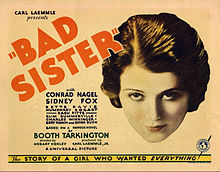Bad Sister (1931 film)
| Bad Sister | |
|---|---|

Lobby card
|
|
| Directed by | Hobart Henley |
| Produced by | Carl Laemmle, Jr. |
| Written by |
Edwin H. Knopf Tom Reed Raymond L. Schrock Based on a novel by Booth Tarkington |
| Starring |
Conrad Nagel Sidney Fox Bette Davis ZaSu Pitts Humphrey Bogart |
| Music by | David Broekman |
| Cinematography | Karl Freund |
| Edited by | Ted J. Kent |
| Distributed by | Universal Pictures |
|
Release date
|
|
|
Running time
|
68 minutes |
| Country | United States |
| Language | English |
Bad Sister is a 1931 American Pre-Code drama film directed by Hobart Henley. The screenplay by Edwin H. Knopf, Tom Reed, and Raymond L. Schrock is based on the 1913 novel The Flirt by Booth Tarkington, which had been filmed in 1916 and 1922.
The film marks the screen debut of Bette Davis and Sidney Fox, who was billed over Davis. It also features Humphrey Bogart and ZaSu Pitts in supporting roles. This film has been preserved in the Library of Congress collection.
Naive Marianne Madison, bored with her routine life, falls for dashing con artist Valentine Corliss, who has come to her small town looking for fresh marks to swindle. He soon charms her into faking her wealthy and prominent father's name on a letter of endorsement, which he presents to the other local merchants, who willingly give him merchandise. He prepares his escape, but not before conning Marianne into becoming his wife.
Following their wedding night in a sleazy hotel, Valentine abandons Marianne. She returns home and begs forgiveness from her jilted fiancé Dick Lindley, but having seen Marianne for who she really is, he turns his attention to her shy younger sister Laura.
The film originally was called What a Flirt and then Gambling Daughters before being changed to Bad Sister just prior to its theatrical release.
Bette Davis, nervous about her appearance in her first film, consulted with studio makeup chief Jack Pierce, who "surveyed me critically, almost resentfully," she recalled for an interview in the April 1938 issue of Good Housekeeping. "Your eyelashes are too short, hair's a nondescript color, and mouth's too small. A fat little Dutch girl's face, and a neck that's too long," he told her. He suggested a different shade of lipstick and advised her to use eye shadow, but their meeting left Davis feeling anxious and lacking self-confidence. After seeing the completed film, producer Carl Laemmle, Jr. commented, "Can you imagine some poor guy going through hell and high water and ending up with her at the fade-out?"
...
Wikipedia
